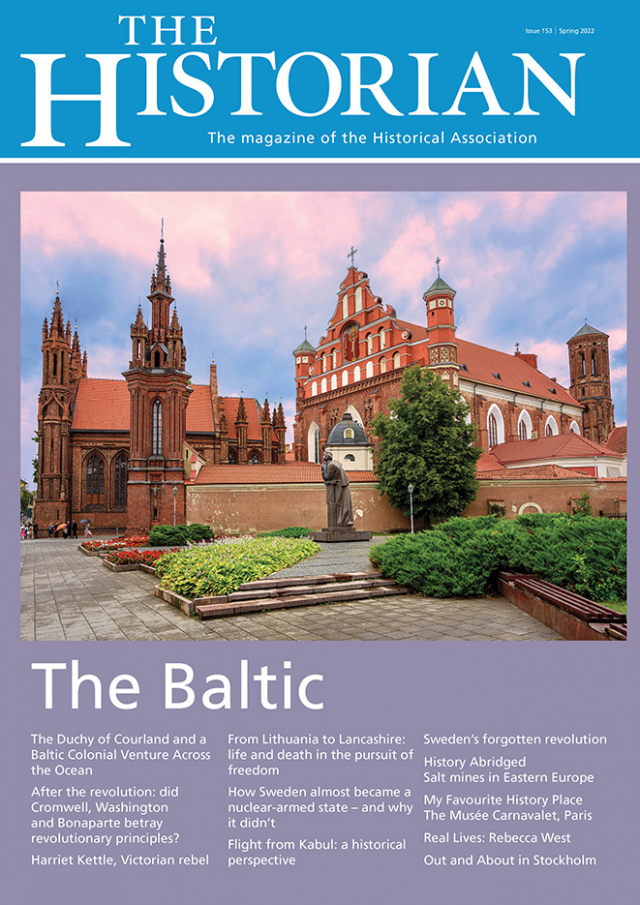The Historian 153: Out now
The magazine of the Historical Association

Editorial: The Baltic
Read The Historian 153: The Baltic
It once seemed natural for anyone leaving Britain to go south, rather than north. There were practical reasons for this. British tourists understandably wanted sunshine, and a sea they could swim in without first taking a deep breath: the Mediterranean provided both. If they spoke a foreign language at all, it was likely to be French. The classical education of the elite also provided some sort of context for travel in southern climes. But above all, the south was cheap.
By contrast, few knew very much about the Baltic. After all, in our own day, a British Foreign Secretary appeared to confuse it with the Black Sea, without attracting much domestic ridicule. Perhaps travellers feared that since the region was cold and dark for much of the year, it might be even less hospitable than their own islands. Not many people in Britain learned Swedish, or had much grasp of even the very recent history of, say, Finland or Estonia. The north was also widely supposed to be prohibitively expensive. When the impecunious Durrell family fled Bournemouth in 1935, they went to Corfu: it didn’t occur to them to make for Tallinn.
In this edition of The Historian, there are several articles which seek to contest such traditional views of the Baltic, and to demonstrate that the history of Northern Europe is as rewarding, complex and unexpected as any. Simon Bromiley uses a family connection to explore the fate of Lithuania in the twentieth century, squeezed as it has always been between Russia and Germany.
Perhaps inevitably, Sweden looms large in any examination of the Baltic. Naman Habtom looks at the extraordinary, and virtually unknown, story of how Sweden very nearly adopted nuclear weapons, and why, in the end, it failed to do so. An article on Sweden’s revolution of 1718–20 attempts to clarify both what happened and why it has been largely forgotten, not least in Sweden itself.
John Freeman writes of a little-known aspect of the Baltic in his examination of the Duchy of Courland’s ambitions in Tobago and the Gambia. Few people associate the region with colonial expansion across the Atlantic: this is an article which enlarges our understanding, not just of the Baltic, but of the wider world beyond it.
This is predominantly a Baltic edition, but there are also other histories – to adopt a currently popular expression. Andy Reid introduces to us a remarkable Victorian in the person of the rebellious Harriet Kettle. Nowadays, a claim to victimhood is a much-prized asset. Here is a reminder that not everyone chooses to think of themselves in such terms, and that resistance to authority can take diverse forms.
Gregory Gifford maintains a certain revolutionary theme by comparing and contrasting the emergence of the three military figures who emerged from their very different revolutions: Cromwell; Washington and Bonaparte. He explores the paradox that each faced in his different way: that the securing of revolutionary gains might mean the sacrifice of revolutionary principles.
In an article of obvious contemporary relevance, Matt Jux-Blayney examines the First Afghan War. With his own experience of soldiering there, he indicates a certain consistency of outcome in attempts to subdue that country, and compares recent events with the catastrophic retreat from Kabul in 1842.
In our regular features, Seán Lang tells us why his favourite place is the Musée Carnavalet in Paris, and Paula Kitching examines the real life of Rebecca West. We also go out and about in Stockholm.
Louis MacNeice – whose time with W H Auden in that Nordic outlier, Iceland, was so enjoyable that the two produced a book about it – once wrote that the world was ‘incorrigibly plural’. Indeed it is. And so, I hope, is this edition of The Historian.

